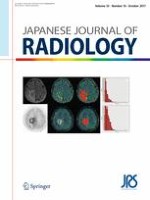Erschienen in:

28.07.2017 | Original Article
Renal dysfunction after abdominal or thoracic endovascular aortic aneurysm repair: incidence and risk factors
verfasst von:
Shuji Ikeda, Makiyo Hagihara, Akira Kitagawa, Yuichiro Izumi, Kojiro Suzuki, Toyohiro Ota, Tsuneo Ishiguchi, Hiroyuki Ishibashi
Erschienen in:
Japanese Journal of Radiology
|
Ausgabe 10/2017
Einloggen, um Zugang zu erhalten
Abstract
Purpose
To determine the incidence and risk factors of renal dysfunction after abdominal endovascular aortic repair (EVAR) and thoracic endovascular aortic repair (TEVAR).
Materials and methods
The study consisted of 227 patients treated with EVAR and 90 with TEVAR for aortic aneurysms. Parameters, including patients’ background factors, preoperative renal function, contrast dose and aortic wall irregularity on CT images were assessed in relation to postoperative renal dysfunction.
Results
Deterioration of renal function was observed in 33 of 218 patients (15.1%) after EVAR and in 7 of 79 (8.9%) patients after TEVAR. Hemodialysis was required in one patient after EVAR. In EVAR, renal dysfunction correlated with age (p = 0.034) and occlusion of accessory renal artery (p = 0.0001). In TEVAR, renal dysfunction correlated with age (p = 0.021), contrast dose (p = 0.042) and irregularity of the descending aortic wall (p = 0.023). In a multiple regression analysis, postoperative renal dysfunction was correlated with occlusion of accessory renal artery (p = 0.0003) after EVAR, and age (p = 0.02), contrast dose (p = 0.026) and irregularity of the descending aortic wall (p = 0.042) after TEVAR.
Conclusion
Occlusion of accessory renal artery in EVAR, and age, contrast dose and irregularity of the descending aortic wall in TEVAR were considered to be predictors of postoperative renal dysfunction.